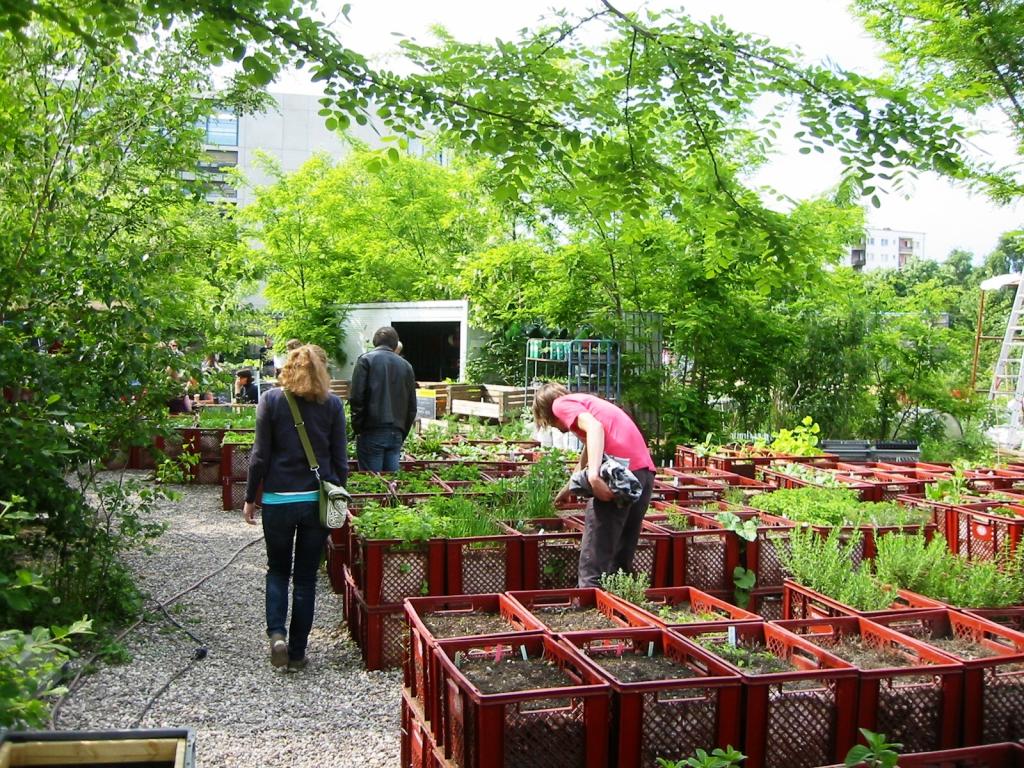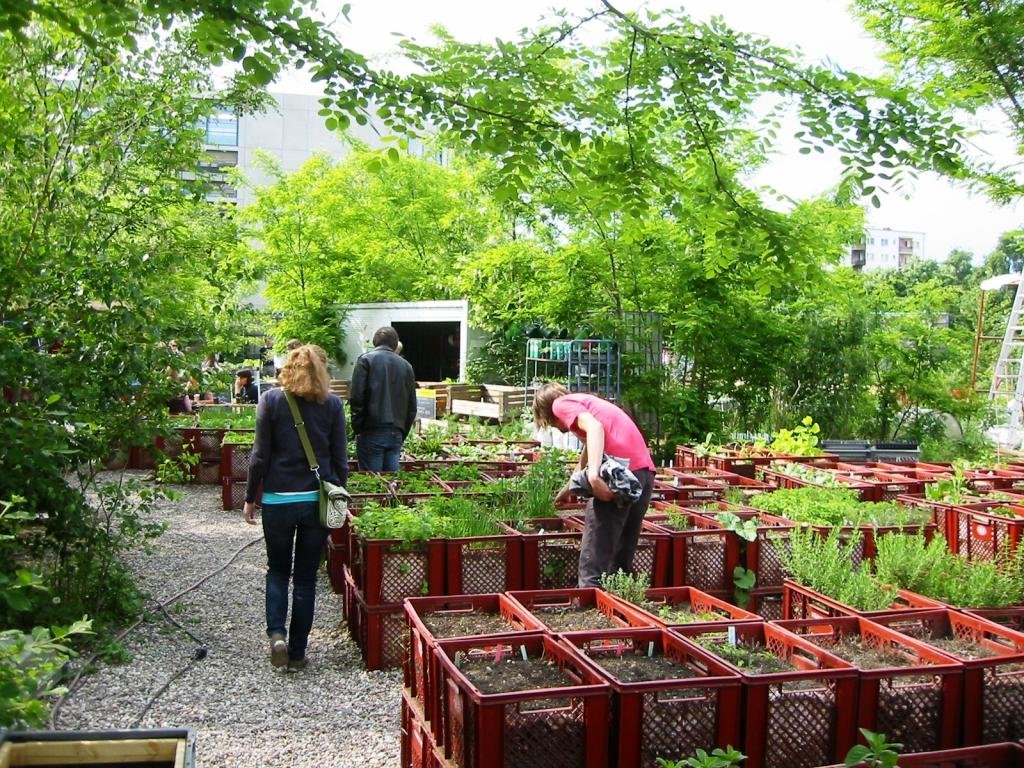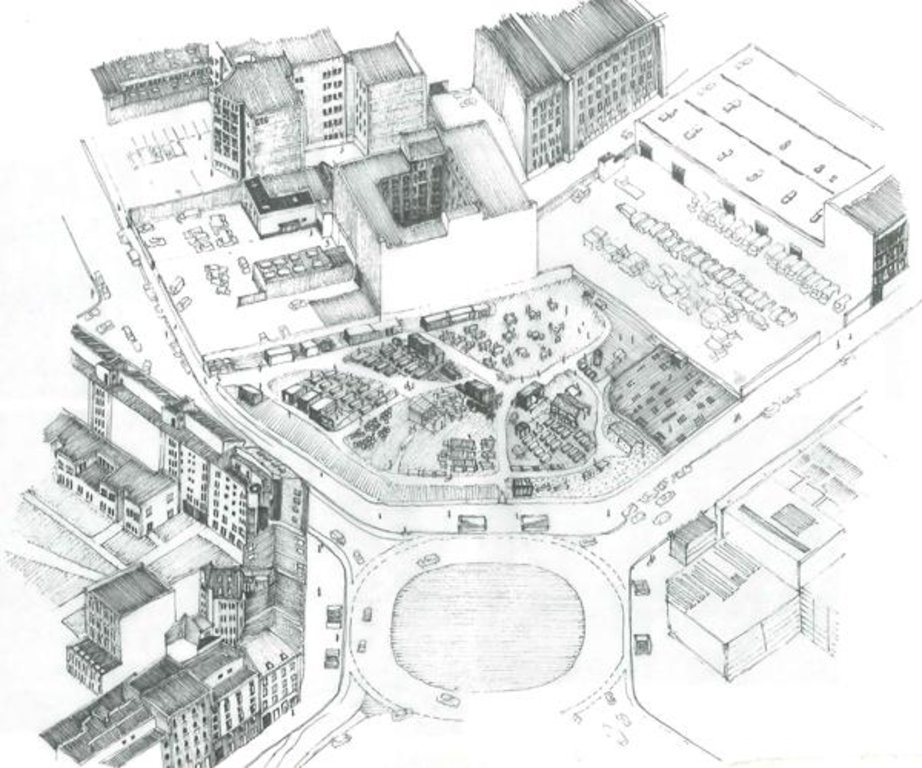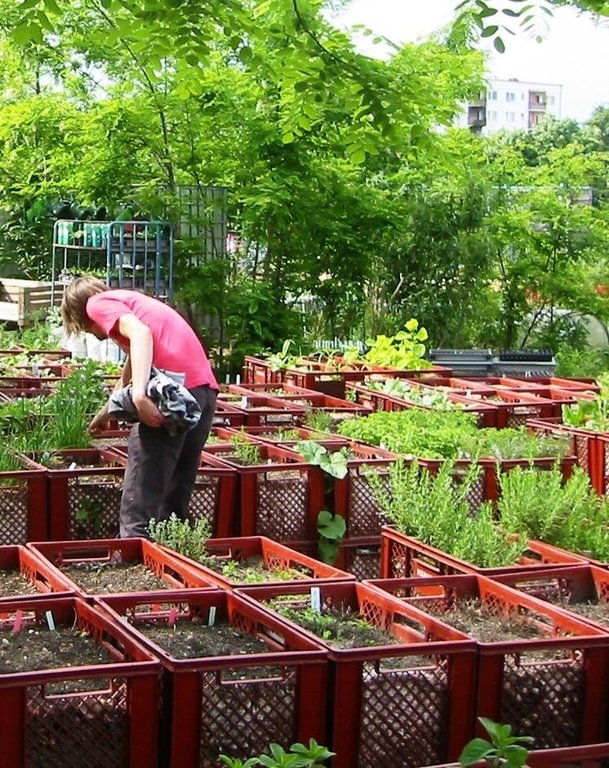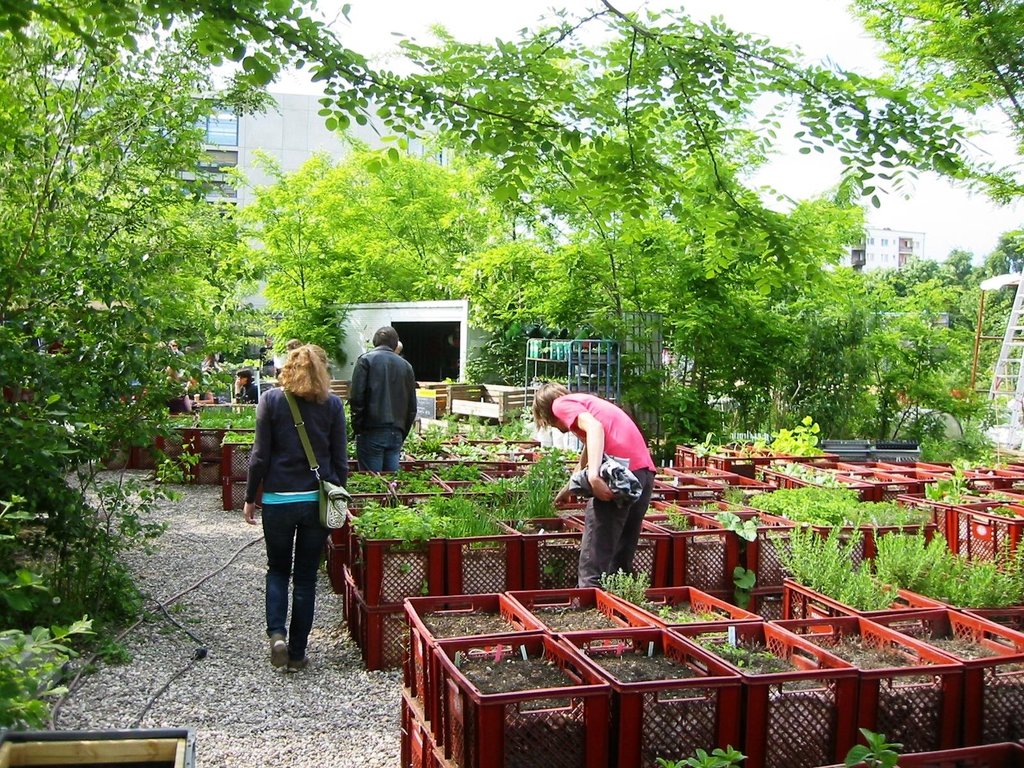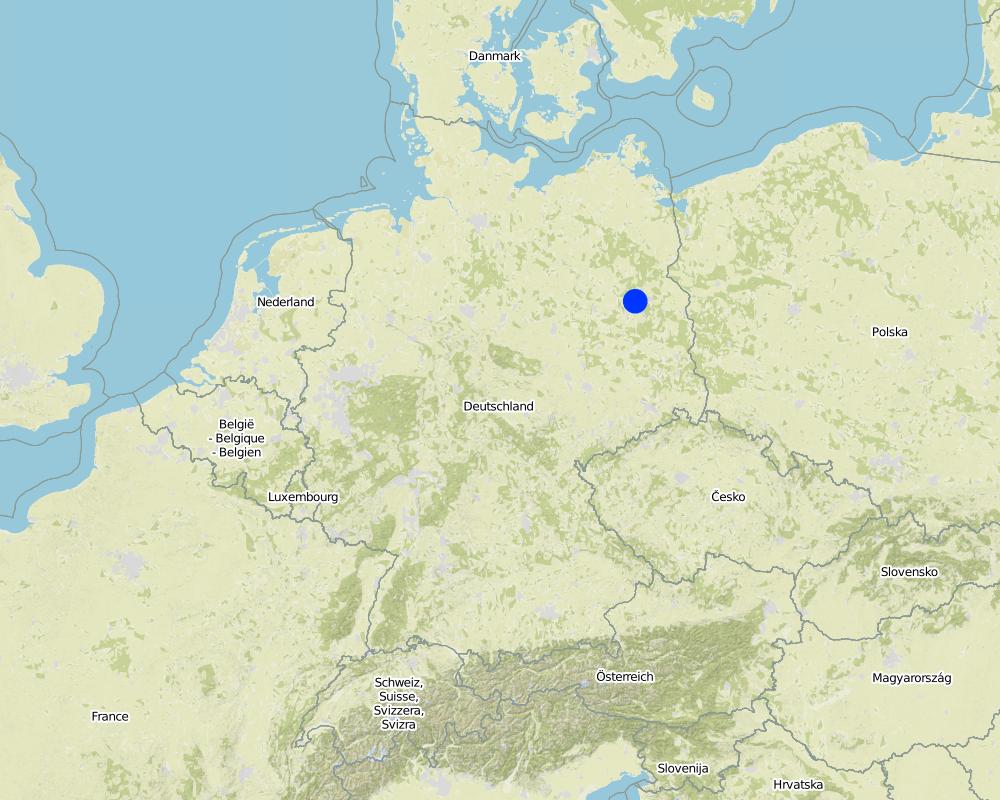Mobile Community Garden [ألمانيا]
- تاريخ الإنشاء:
- تحديث:
- جامع المعلومات: Peter Kirch
- المحرر: –
- المُراجع: Fabian Ottiger
approaches_2603 - ألمانيا
عرض الأقسام
توسيع الكل طي الكل1. معلومات عامة
1.2 تفاصيل الاتصال بالأشخاص الرئيسيين لمصدر المعلومات والمؤسسات المعنية بتقييم وتوثيق النهج
متخصص في الإدارة المستدامة للأراضي:
Shaw Robert
kontakt@prinzessinnengarten.net
PRINZESSINNENGARTEN BERLIN
Prinzenstrasse 35 – 38, Berlin
ألمانيا
اسم المؤسسة (المؤسسات) التي سهلت توثيق/تقييم النهج (إذا كان ذلك على صلة)
Technische Universität Berlin (Technische Universität Berlin) - ألمانيا1.3 الشروط المتعلقة باستخدام البيانات الموثقة من خلال WOCAT
متى تم تجميع البيانات (ميدانيا)؟:
08/05/2015
يوافق جامع المعلومات والشخص (لاشخاص) الرئيسي لمصدر المعلومات على الشروط المتعلقة باستخدام البيانات الموثقة من خلال WOCAT:
نعم
2. وصف نهج الإدارة المستدامة للأراضي
2.1 وصف موجز للنهج
The SLM approach can be defined as community supported mobile urban farm, which serves the goals of vegetable production, and place of learning and knowledge sharing.
2.2 وصف تفصيلي للنهج
وصف تفصيلي للنهج:
Aims / objectives: The objective of the SLM approach 'Prinzessinnengarten' was to create an urban garden on a waste land plot in the center of Berlin. The plot was characterised by having sealed and contaminated soils, which is characteristic for open land plots in most urban areas. The garden is supposed to practically demonstrate an ecologically and socially different approach to urban spaces and their inhabitants, enable the social empowerment of marginalized communities. Furthermore opportunities for local micro-economies and other economic models are supposed to be created. In an unobtrusive and pragmatic way, urban gardens in general aim to raise the question of 'How we want to live in our cities in the future?
Methods: The project was first was implemented by the group Nomadisch Grün (Nomadic Green) in summer of 2009. Along with friends, activists and neighbours, the group realised the first steps of implementation through clearing of rubbish and through the construction of the first cultivation units. The project, being open to everybody, attracted new participants quite fast. Now the garden owes its existence to the commitment of countless neighbors and interested people. The work of these participants, their diverse skills and ideas transform the place continuously.
Stages of implementation: I. Development of the idea. During this phase of implementation mainly Robert Shaw (he was involved in similar projects in Cuba before) and Marco Clausen were involved.. II. Implementation in practice. Starting in summer of 2009, the project idea was being implemented on the ground by a group of people. During this stage of implementation mainly physical work, such as the clearing of rubbish was realised. III. Opening to the wider public (still ongoing). The non-profit company 'Nomadisch Grün (Nomadic Green) serves as a framework for the different social, educational and economic activities with the primary aim of making the garden a place of learning. Skills are gained through practical experience and knowledge sharing.
2.3 صور عن النهج
2.5 البلد/المنطقة/المواقع التي تم تطبيق النهج فيها
البلد:
ألمانيا
المنطقة/الولاية/المحافظة:
Berlin
مزيد من التفاصيل حول الموقع:
Kreuzberg
Map
×2.6 تواريخ بدء وإنهاء تنفيذ النهج
أشر إلى سنة البدء:
2009
2.7 نوع النهج
- مبادرة محلية حديثة/مبتكرة
2.8 الغايات/الأهداف الرئيسية للنهج
The Approach focused mainly on other activities than SLM (utilisation of waste land/abandoned land plots, urban areas,production of vegetables, place of knowledge sharing)
The aim of the project was to find solutions for the lack of knowledge sharing within the society and to address the topic of food production.
The SLM Approach addressed the following problems: The main problems addressed by the approach can be described as manifold, e.g. insufficient local food production, or the general lack of public spaces for knowledge sharing and exchange within the community.
2.9 الظروف التي تمكن أو تعيق تنفيذ التقنية/التقنيات المطبقة بموجب النهج
توفر/الوصول إلى الموارد والخدمات المالية
- معيق
Treatment through the SLM Approach: attempt to diversify the income
الإطار المؤسساتي
- معيق
no official institution is clearly responsible for this type of approach
Treatment through the SLM Approach: regular exchange with politicians, especially on local level
الإطار القانوني (حيازة الأراضي، وحقوق استخدام الأراضي والمياه)
- تمكين/تمكيني
The existing land ownership, land use rights / water rights helped a little the approach implementation: As the existing land ownership was already known before the implementation of the approach started, this aspect was being strongly considered (leading to the design of a mobile cultivation system). Furthermore the existing land ownership (the community is owning the land) led to the possibility to have public negotiations about the renting contract. If the area would have been in private ownership such negotiations would not have been possible and it is more than likely that the Approach could not have been realised in the way it is realised now.
- معيق
no long term renting contract, no official institution is clearly responsible for this type of approach
Treatment through the SLM Approach: political campaign
عبء العمل، توفر القوى العاملة
- معيق
due to the high presence in the media there is a high demand for communication acitivities
Treatment through the SLM Approach: establishment of paid jobs to have people working professionally on certain topics
3. المشاركة وأدوار الأطراف المعنية
3.1 أصحاب المصلحة المعنيون بالنهج وأدوارهم
- مستخدمو الأراضي المحليون/المجتمعات المحلية
In the surroundings of the Moritzplatz a great part of the population were/are immigrants (most of them coming from muslim countries) and people without a job. In principle the project was/is open for all people, including disadvantaged groups as well. During the interviews it was said though that the selling and consumption of alcohol on the project area could have led to the fact that especially immigrants from muslim countries could have been felt excluded.
3.2 انخراط مستخدمي الأراضي المحليين/المجتمعات المحلية في المراحل المختلفة للنهج
| انخراط مستخدمي الأراضي المحليين/المجتمعات المحلية | حدد من شارك وصف الأنشطة | |
|---|---|---|
| المبادرة/التحفيز | التعبئة الذاتية | There was a constant change of the people that were being involved in the different phases of the project. The decision to what degree people got involved, were to be taken under the consideration of the personal needs and possibilities. |
| التخطيط | التعبئة الذاتية | There was a constant change of the people that were being involved in the different phases of the project. The decision to what degree people got involved, were to be taken under the consideration of the personal needs and possibilities. |
| التنفيذ | التعبئة الذاتية | There was a constant change of the people that were being involved in the different phases of the project. The decision to what degree people got involved, were to be taken under the consideration of the personal needs and possibilities. |
| الرصد/التقييم | التعبئة الذاتية | There was a constant change of the people that were being involved in the different phases of the project. The decision to what degree people got involved, were to be taken under the consideration of the personal needs and possibilities. |
| Research | تفاعلي |
3.4 اتخاذ القرار بشأن اختيار تقنية/تقنيات الإدارة المستدامة للأراضي
حدد من الذي قرر اختيار التقنية/التقنيات التي سيتم تنفيذها:
- مستخدمو الأراضي وحدهم (المبادرة الذاتية)
اشرح:
Decisions on the method of implementing the SLM Technology were made by by land users* alone (self-initiative / bottom-up)
4. الدعم الفني وبناء القدرات وإدارة المعرفة
4.1 بناء القدرات/التدريب
هل تم تقديم التدريب لمستخدمي الأراضي / الأطراف المعنيين الآخرين؟:
نعم
حدد من تم تدريبه:
- مستخدمو الأراضي
شكل التدريب:
- في العمل
- من مزارع إلى مزارع
- مناطق العرض
- اجتماعات عامة
- دورات
المواضيع المغطاة:
Through creating a open public space/place and by offering manifold practical activity the approach provides training by using a peer to peer approach on topics like biodiversity, healthy eating, recycling, environmental justice, climate change and food sovereignty. This training / awareness raising takes place informally (peer to peer) as well as formally (announced courses, lectures, discussions)
4.2 خدمة استشارية
هل يملك مستخدمو الأراضي وصولا إلى خدمة استشارية؟:
نعم
وصف/تعليقات:
Advisory service is inadequate to ensure the continuation of land conservation activities
4.3 تعزيز المؤسسات (التطوير التنظيمي)
هل تم إنشاء أو تعزيز مؤسسات من خلال هذا النهج؟:
- لا
4.4 الرصد والتقييم
هل يشكل الرصد والتقييم جزءا من النهج؟:
نعم
التعليقات:
bio-physical aspects were ad hoc monitored by land users through observations
bio-physical aspects were regular monitored by other through measurements
technical aspects were ad hoc monitored by land users through observations
socio-cultural aspects were ad hoc monitored by land users through observations
economic / production aspects were ad hoc monitored by land users through observations
no. of land users involved aspects were ad hoc monitored by land users through observations
management of Approach aspects were ad hoc monitored by land users through observations
There were several changes in the Approach as a result of monitoring and evaluation: There is a constant change according to the findings of the monitoring and the needs/possibilites of the project participants.
There were few changes in the Technology as a result of monitoring and evaluation: The research of the Technical University of Berlin showed that vegetables which were cultivated very close to the street, contained more pollutants. Therefore a 'green belt' of about 2 m width was established around the garden, where only non-food-crops are cultivated
4.5 البحوث
هل كانت البحوث جزءًا من النهج؟:
نعم
حدد المواضيع:
- علم الايكولوجيا
أعط تفاصيل إضافية وأشر إلى من قام بالبحوث:
There was research on the soil and plant quality and possible contamination of the soil and the plants (performed e.g. by the Technical University of Berlin)
Research was carried out both on station and on-farm
5. التمويل والدعم المادي الخارجي
5.1 الميزانية السنوية لمكون الإدارة المستدامة للأراضي في النهج المذكور
إذا لم تكن الميزانية السنوية الدقيقة معروفة، قم بالإشارة إلى نطاقها:
- 1,000000-100،000
التعليقات (على سبيل المثال المصادر الرئيسية للتمويل/الجهات المانحة الرئيسية):
Approach costs were met by the following donors: local community / land user(s): 100.0%
5.2 الدعم المالي/المادي المقدم لمستخدمي الأراضي
هل حصل مستخدمو الأراضي على دعم مالي/ مادي لتنفيذ التقنية/ التقنيات؟:
نعم
5.3 إعانات لمدخلات محددة (بما في ذلك العمالة)
- بنى تحتية
| حدد المدخلات التي تم دعمها | إلى أي مدى | حدد الإعانات |
|---|---|---|
| Kitchen | ممول جزئيا | For educational purposes |
إذا كان العمل من قبل مستخدمي الأراضي مدخلاً جوهريًا، فهل كان:
- تطوعي
5.4 الائتمان
هل تم توفير ائتمان في إطار نهج أنشطة الإدارة المستدامة للأراضي؟:
كلا
6. تحليل الأثر والتصريحات الختامية
6.1 آثار النهج
هل ساعد النهج مستخدمي الأراضي على تنفيذ وصيانة تقنيات الإدارة المستدامة للأراضي؟:
- لا
- نعم، قليلا
- نعم، باعتدال
- نعم، إلى حد كبير
The approach helped the land users to cultivate on areas, which were not suitable for cultivation before. Furthermore the approach enhanced the knowledge sharing concering different topics regarding sustainable land management. Therefore the impact of the Approach on SLM is not only to be measured on the project area itself, but also under consideration of the outreach of the project.
هل ساهم النهج في تمكين الفئات المحرومة اجتماعيا واقتصاديا؟:
- لا
- نعم، قليلا
- نعم، باعتدال
- نعم، إلى حد كبير
Through the Approach a space for knowledge sharing was created, which is also open for socially and economically disadvantaged groups. The utilisation of this space by the groups in question is limited up to date though.
Did other land users / projects adopt the Approach?
- لا
- نعم، قليلا
- نعم، باعتدال
- نعم، إلى حد كبير
The approach was adopted in modified ways in several urban gardening projects accross Germany. It is not possible to quantify the number. A guess would be around 20.
Did the Approach lead to improved livelihoods / human well-being?
- لا
- نعم، قليلا
- نعم، باعتدال
- نعم، إلى حد كبير
Creation of a space open to the public, which is dedicated for knowledge sharing.
Did the Approach help to alleviate poverty?
- لا
- نعم، قليلا
- نعم، باعتدال
- نعم، إلى حد كبير
The goal of the approach was not set on the alleviation of poverty.
6.2 المحفز الرئيسي لقيام مستخدمي الأراضي بتنفيذ الإدارة المستدامة للأراضي
- زيادة الإنتاج
- الانتماء إلى حركة/ مشروع/ مجموعة/ شبكات
- الوعي البيئي
- well-being and livelihoods improvement
6.3 استدامة أنشطة النهج
هل يمكن لمستخدمي الأراضي المحافظة على استدامة ما تم تنفيذه من خلال النهج (بدون دعم خارجي)؟:
- نعم
إذا كانت الإجابة بنعم، صف كيف:
Through the diverse income opportunities (consulting, selling/using the produce in gastronomy, donation) the Approach activities can be self-financed.
6.4 نقاط قوة/مزايا النهج
| نقاط القوة/ المزايا/ الفرص من وجهة نظر مستخدمي الأراضي |
|---|
| not dependent on a certain plot (mobility, flexibility) |
| flat hierachy leads to the fact, that a lot of people can bring in their ideas easily |
| Everybody can decide on his/her own to what extend he/she wants to get involved and in what kind of activity. Through this the participants can focus on their strengths and there is little chance that overworking occurs. |
| Creation of paid jobs |
| نقاط القوة/ المزايا/ الفرص من وجهة نظر جامع المعلومات أو غيره من الاشخاص الرئيسيين لمصدر المعلومات |
|---|
| self-financed |
| sharing of knowledge (possible between all participants) |
| open to everybody |
6.5 نقاط الضعف/ العيوب في المنهج وطرق التغلب عليها
| نقاط الضعف/ المساوىء/ المخاطر من وجهة نظر مستخدم الأراضي | كيف يمكن التغلب عليها؟ |
|---|---|
| only to a certain point 'sustainable', as the project is dependent on a great amount of external inputs (water, plastic boxes) |
| نقاط الضعف/ المساوىء/ المخاطر من وجهة نظر جامع المعلومات أو غيره من الاشخاص الرئيسيين لمصدر المعلومات | كيف يمكن التغلب عليها؟ |
|---|---|
| only to a certain point 'sustainable', as the project is dependent on a great amount of external inputs (water, plastic boxes) |
7. المراجع والروابط
7.1 طرق جمع/مصادر المعلومات
- زيارات ميدانية، مسوحات ميدانية
- مقابلات مع مستخدمي الأراضي
7.2 المراجع للمنشورات المتاحة
العنوان، المؤلف، السنة، النظام القياسي الدولي لترقيم الكتب ISBN:
website, 2015
متاح من أين؟كم التكلفة؟:
prinzessinnengarten.net/
الروابط والوحدات المواضيعية
توسيع الكل طي الكلالروابط
لا يوجد روابط
الوحدات المواضيعية
لا يوجد وحدات مواضيعية


